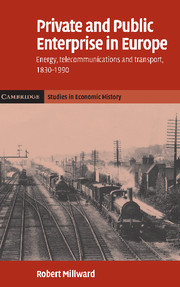Book contents
- Frontmatter
- Contents
- List of figures
- List of tables
- Preface
- Glossary and abbreviations
- Map: The European economy in 1914
- Part I Introduction
- Part II The Construction of the New European Infrastructure c. 1830–1914
- Part III Nations and Networks c. 1914–1945
- 6 Infrastructure development from the nineteenth to the twentieth century: an overall perspective
- 7 The development of telecommunications
- 8 Network integration in electricity supply: successes and failures
- 9 Railway finances and road–rail competition
- Part IV State Enterprise c. 1945–1990
- Part V Conclusions
- Appendix: Infrastructure service levels and public ownership c. 1910: a statistical analysis
- Bibliography
- Index
9 - Railway finances and road–rail competition
Published online by Cambridge University Press: 14 July 2009
- Frontmatter
- Contents
- List of figures
- List of tables
- Preface
- Glossary and abbreviations
- Map: The European economy in 1914
- Part I Introduction
- Part II The Construction of the New European Infrastructure c. 1830–1914
- Part III Nations and Networks c. 1914–1945
- 6 Infrastructure development from the nineteenth to the twentieth century: an overall perspective
- 7 The development of telecommunications
- 8 Network integration in electricity supply: successes and failures
- 9 Railway finances and road–rail competition
- Part IV State Enterprise c. 1945–1990
- Part V Conclusions
- Appendix: Infrastructure service levels and public ownership c. 1910: a statistical analysis
- Bibliography
- Index
Summary
By the 1930s, railway systems everywhere in Europe were in desperate financial straits. German rail revenues in 1933, for example, could not even cover operating costs. In Britain, the margin was inadequate to meet interest charges, and this was true for the trunk lines in Sweden run by the state railways (Statens Järnvägar, SJ), whose gross annual profits on average over the period 1931–5 were 33 million kroner, not enough to cover interest and related capital charges of 40 million kroner; the local and provincial lines run by private companies were in even worse financial condition. In France in 1933, the balance over all networks after meeting all capital charges was a deficit of 3860 million francs. Of course, general economic conditions in these depression years were bad, and some recovery took place in the second half of the 1930s. The financial problems did not, however, disappear. The deficits in French railways rose to 5934 million francs in 1937 and, as Dormois says, as an ‘outcome of decades of subsidisation and regulations’, was an ingredient in the nationalisation of the networks in the same year, to be followed by Sweden in 1939, Spain in 1944 and Britain in 1947. Although the slogans under which this occurred were sometimes ‘socialism’ or ‘autarky’, the takeovers commanded wide support and reflected the inherent problems of economic organisation that were to bedevil inland surface transport for the rest of the century.
- Type
- Chapter
- Information
- Private and Public Enterprise in EuropeEnergy, Telecommunications and Transport, 1830–1990, pp. 146 - 168Publisher: Cambridge University PressPrint publication year: 2005

